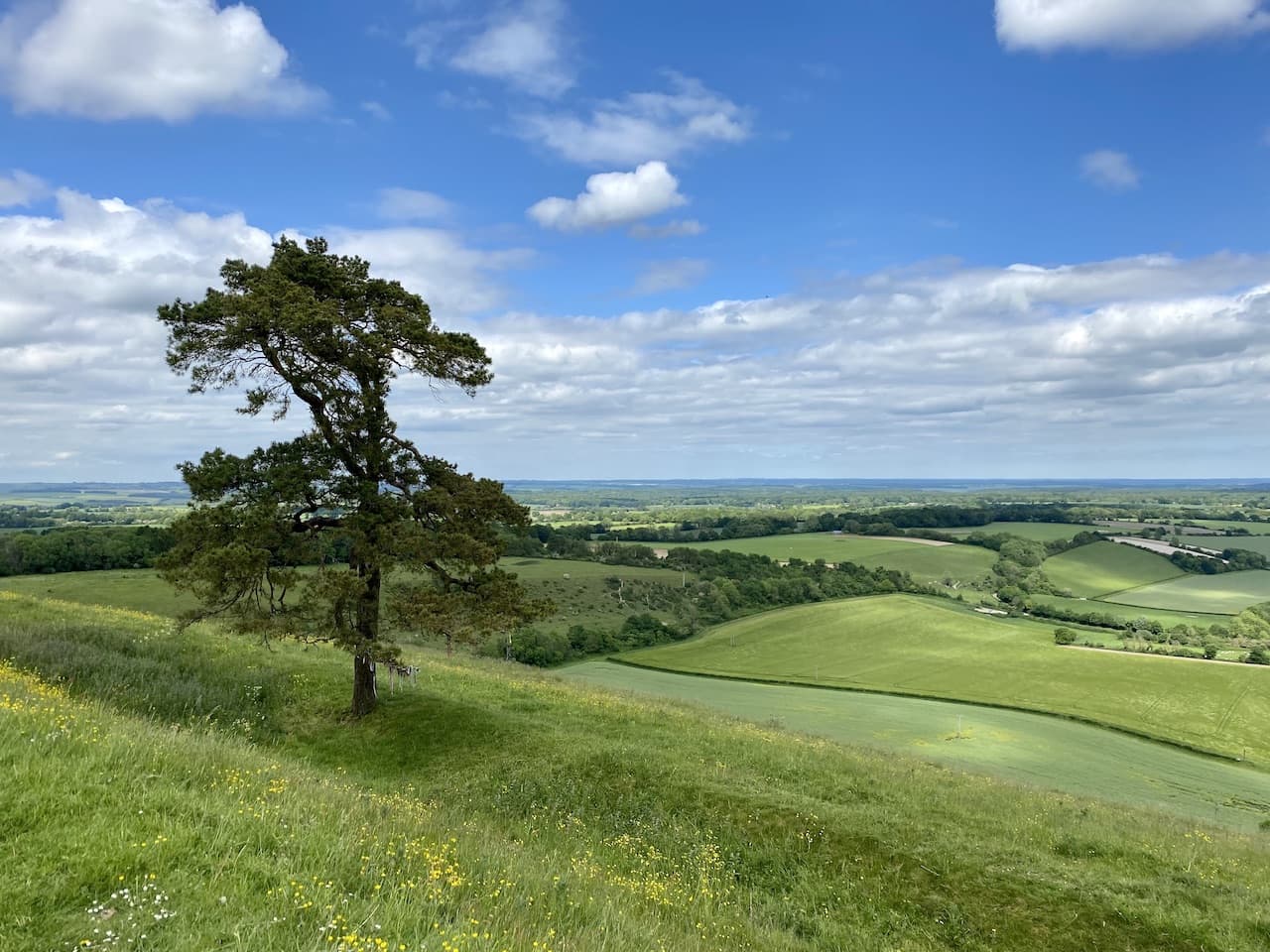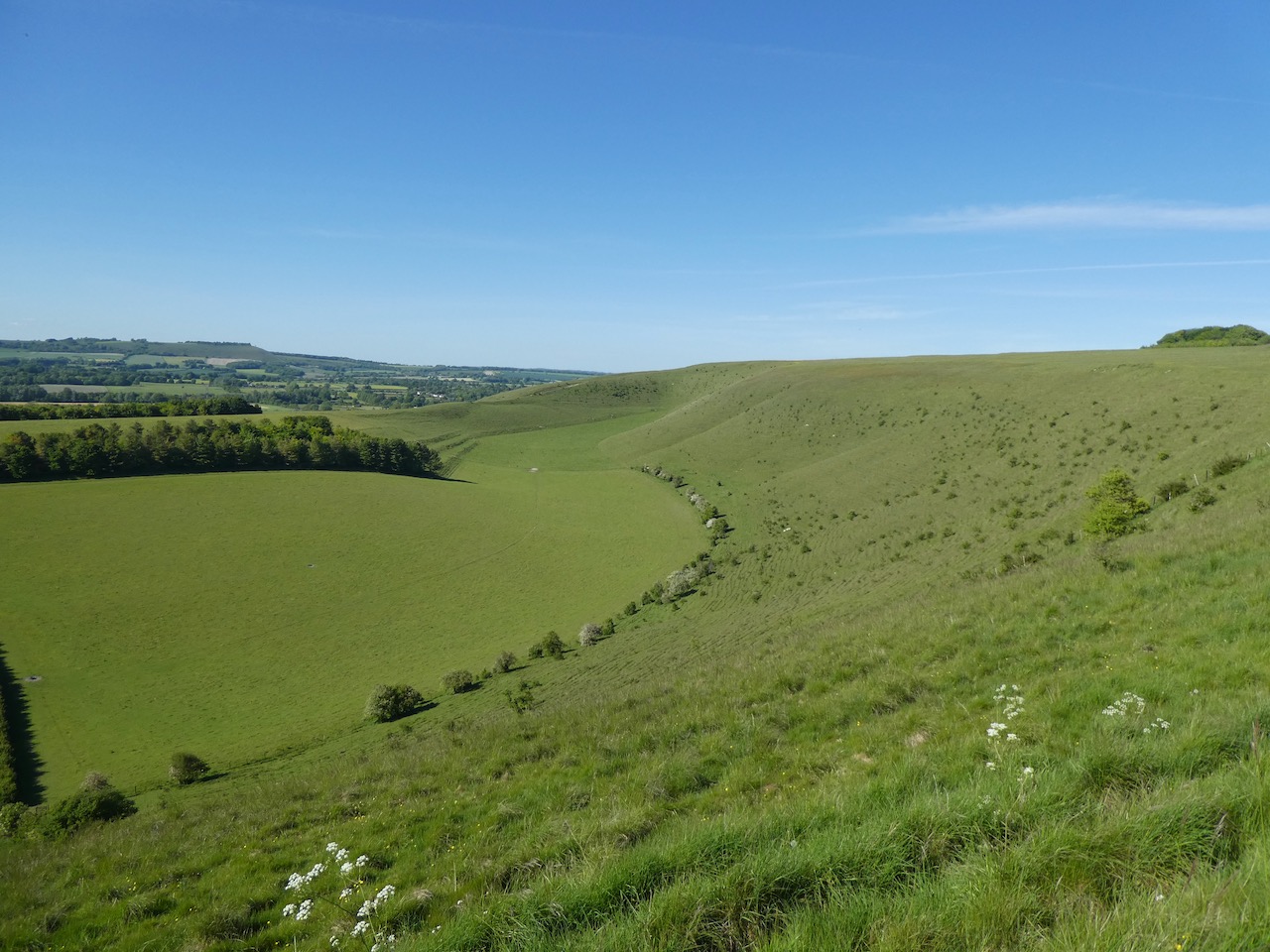Overgrown and poorly maintained footpaths marred our walk yesterday and I am not keen to repeat the experience so have planned a walk in an area I know will be hassle free. It will combine a section of the Kennet and Avon Canal and also take us to the stunning Martinsell Hill.
The starting point for our walk is the free car park in the centre of Pewsey off Goddard Road (Grid Ref: SU162601). Leaving the car park we walk back to the A345 the main road through Pewsey and turn right by the Post Office and follow the road as it goes through the village and when it bends to the right we turn left into Church Lane.
We soon cross the River Avon and then follow a footpath skirting the grounds of Offices and follow this past Pewsey Vale football ground to reach Eastern Lane. Here we turn right and then very soon reach Ball Lane where turn left into Ball Road and head north to reach a junction with a fine old lamp post and signpost.

Here we turn right and then very soon meet a mini roundabout where we turn left into Hollybush Lane. We are on the route of the White Horse Trail and at a fork in the road go right where Hollybush Lane continues along a single track lane. After going under a railway bridge we continue past cottages. Here we stay with the White Horse Trail as it heads steadily downhill on a path leading towards a footbridge over the River Avon.

After crossing the river we are very soon at Pains Bridge where we take the footpath on the right to join the towpath of the Kennet and Avon Canal. We have walked many sections of this canal, but this is the first time on this section.

It is a cracking afternoon to be walking along the canal and this is a very quiet length of towpath. As we walk along we spot a World War II pillbox in a field on the opposite side of the canal. This is one of a series of such boxes built along the edge of the canal to form the GHQ Blue Line a section of the General Headquarters Line which compartmentalised the Country to thwart the expected German Invasion.

The next bridge we reach is the Milkhouse Water Bridge (No.112) which we pass under and continue on the towpath through the open countryside.

I enjoy walking on canal towpaths and find the engineering involved in constructing these waterways very interesting. Lynnie is less keen, especially if we spend hours walking along them, however, she does enjoy walking along the level path with no hills to climb. Although, I have planned a bit of that for later on.

After around two miles on the towpath we reach Wootton Rivers Bridge and Lock. Here we cross the bridge to walk into the village.

It has turned into a very hot day and on reaching St Andrew’s Church we look for a bench in the shade to stop for lunch. This church was rebuilt in 1860 and the steeple has a three faced clock which was built in 1911 to commemorate the coronation of King George V.

Refreshed we resume our walk and continue through the village heading north to pass the Royal Oak pub.

We leave the road at a fork to take a footpath along a track to the left of a thatched cottage.

The track soon starts to head uphill between fields.

On reaching the top of the track we turn right to take a footpath that skirts along the southern edge of the field.

On joining another track we turn left to walk uphill to a junction with a tree lined track, Mud Lane, here we turn left and follow the lane along the top of the ridge.

At this time of the year there is not much mud in Mud Lane, however, a couple of areas still remain a bit sticky so it is easy to see how it acquired it’s name. We stay with the lane to reach a minor road and then cross to go through a car park to enter the open access land of Martinsell Hill.

This is a stunning spot and although we can wander anywhere we stay with the route of the Mid Wilts Way. This 68-mile route crosses the County from the Berkshire border at Ham, near Hungerford and ends at Mere, close to the Dorset border. It is a walk that I have thought about doing, but the pandemic has made planning it very difficult. Hopefully in 2022 things will have eased and I will be able to fit it in.
We stay with the route way-markers which take us around a copse and then along the top of the steep escarpment of the hill. I have been here a few times, but still wonder at the stunning view.

This is the third highest spot in Wiltshire and on the summit is an Iron Age hill fort with the ramparts still visible.

We follow the path through a gate and pass a bench where a couple are admiring the view. We have a brief conversation and continue on our way. As we walk I say to Lynnie that I think I recognised one of the women on the bench but I can’t place where from. Lynnie says she had the same feeling, it takes about ten minutes for us to realise it was a well known actress. Respect for her privacy prevents me from naming her.
We now go through the edge of woodland and then the path leads along the edge of a field heading towards a gate.

Through the gate we continue along the ridge towards Giant’s Grave which is the site of an Iron Age Promontory Fort which resembles a long barrow.

We pass through the ramparts of the fort to reach the Ordnance Survey trig pillar which is located on the opposite side of the fence. I have bagged this trig a number of times but still admire the views from this cracking spot.

It is now a steep descent from the hill along the fence line. On our previous visits to Martinsell Hill we have walked up this route, but it is far easier on the lungs going down, but harder on the knees. We go through a kissing gate and follow the well-worn path to reach another gate to join a track. Here the Mid Wilts Way turns to the right to head towards Oare, but our route is straight over the track to follow the route of the White Horse Trail.
On reaching Sunnyhill Lane we turn left and then after a couple of hundred yards take a track on the right that leads south towards the Kennet and Avon Canal and Pains Bridge.

After crossing the bridge we continue along the path to cross the River Avon and then as we reach houses turn right to follow a footpath that soon runs besides the railway line and passes an old mill.

We then join a minor road which soon goes under the railway line to reach the A345 where we turn left and follow the pavement down into the centre of Pewsey. There are some interesting independent shops in the village and I am also fascinated by the Shed Alehouse. It is closed, but I later discover that this is a small, basic pub serving ales and ciders from micro-breweries. It lists an amazing number of beers it has served in the past. Just the sort of place I would love to visit, but not when driving.

Soon after passing the Shed Alehouse we reach the Post Office and turn right to return to our starting point. I hope it won’t be too long before we get a chance to visit Martinsell Hill again.
You can view this 11 mile walk on OS Maps and download the GPX File Here
To follow my walk, you will need Ordnance Survey Explorer 157 – Marlborough & Savernake Forest
9th June 2021
© Two Dogs and an Awning (2021)
All information on this site is provided free of charge and in good faith and no liability is accepted in respect of damage, loss or injury which might result from it. To the best of my knowledge the routes are entirely on public rights of way or within areas that are open for public access.
Walking can be hazardous and is done entirely at your own risk. It is your responsibility to check your route and navigate using a map and compass.





























